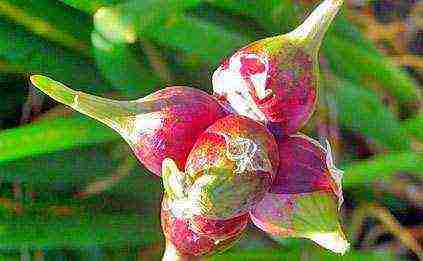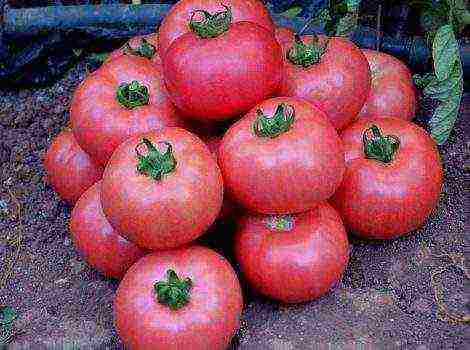Content
- 1 How to choose a cauliflower variety?
- 2 Varieties for different regions
- 3 When to plant cauliflower seedlings?
- 4 Seed preparation
- 5 Soil preparation
- 6 How to prepare a container?
- 7 How to plant seeds?
- 8 How to dive seedlings?
- 9 Cauliflower Seedling Care
- 10 Basic techniques
- 11 Timing
- 12 Preparing the ground in boxes
- 13 Seed preparation
- 14 Transplanting
- 15 Seedlings of cauliflower: how to grow
- 16 Picking
- 17 How to make peat pots
- 18 How to grow cauliflower seedlings in peat tablets
- 19 Growing without picking
- 20 How to fertilize
- 21 Seedling hardening
- 22 How to transfer to open ground
- 23 Which variety should you choose?
- 24 Where to plant cauliflower?
- 25 Preliminary preparation recommendations
- 26 We grow home seedlings
- 27 Recommendations for the care of home seedlings
- 28 Landing
- 29 Cauliflower pests and control
- 30 Seed sowing dates
- 31 What is the substrate made of?
- 32 How do I prepare the seeds?
- 33 Sowing cauliflower seeds
- 34 Seedling care before picking
- 35 Picking cauliflower seedlings
- 36 How to feed the seedlings?
- 37 Hardening of cauliflower seedlings
Cauliflower is a vitamin vegetable with excellent taste and dietary qualities that is superior in nutritional value to other varieties of kale. Its rich mineral composition helps to strengthen the antioxidant defense of a person, and the enzymes contained in cauliflower remove toxins and toxins from the body.
Everyone dreams of growing a decent harvest of cauliflower on their land. To do this, you need to know how and when to plant cauliflower for seedlings, how to grow healthy high-quality seedlings, and determine the optimal time for planting seedlings in a garden bed. The advice of experienced gardeners will help you grow a tasty and healthy vegetable in any region of the country.
How to choose a cauliflower variety?

All cauliflower varieties can be classified into early, medium and late varieties.
Ripening within 100 days and earlier, varieties are classified as early:
- Maliba is an ultra-early super-productive variety with dense rounded heads weighing up to 5 kg, yields a harvest 55-65 days after planting in the ground.
- Amethyst is a mid-early variety that ripens in 80 days from the moment the seedlings are planted in the ground, differs in the same size of heads with a purple tint.
- Fortados is a stress-resistant fruitful variety with dense rounded snow-white heads weighing up to 2 kg, ripens in a few months.
- Snowball 23, Snowdrift - medium early fruitful varieties, ripen in 90-100 days, with white heads weighing 1-1.2 kg, do not lose excellent taste when frozen.
- Popular early varieties: Snow Globe, Regent, Fremont, Blue Diamond, Purple, White Castle, Icing Sugar, Movir-74, Berdegruss.
Medium varieties of cauliflower include ripening for 100-135 days:
- Yako is a high-yielding variety with small heads (about 850 g), suitable for summer and autumn cultivation due to its short ripening period.
- Domestic - a productive variety with a growing season of 100-120 days and small (700-800 g) white heads.
- Flora Blanca is a winter-hardy fruitful variety of Polish selection, the heads are dense, white-yellow, weighing up to 1200 g, ripen almost at the same time after 110 days, are well stored.
- Asterix F1 is a hybrid variety with high resistance to powdery mildew and unfavorable climates, small heads (up to 1 kg) are covered with leaves.
- Lilac ball - resistant to autumn frosts, lilac heads of average density weighing up to 1.5 kg, well stored.
- Mid-season popular varieties: Parisian, Goodman, Belaya Krasavitsa, Dachnitsa, Rushmore, Moscow Cannery, Koza-Dereza, Emeizing.
The group of late varieties includes ripening 4.5-5 months and longer:
- Autumn giant - growing season 200-220 days, has white dense heads weighing up to 2.5 kg.
- Amerigo F1 - high-yielding, frost and heat resistant, snow-white heads weigh up to 2.5 kg.
- Regent - tolerates autumn frosts, head weight 530-800 g.
- Cortes F1 is a hybrid with a high yield, requires fertile soil, tolerates frost well due to the head covered with leaves, the inflorescences are white, dense, weigh up to 3 kg.
- Consista - very late, perfectly tolerates autumn frosts, dense heads weigh up to 800 g.
- Popular late-ripening varieties: Amsterdam, Incline, Altamira, Sochinskaya, Adler winter.
Varieties for different regions
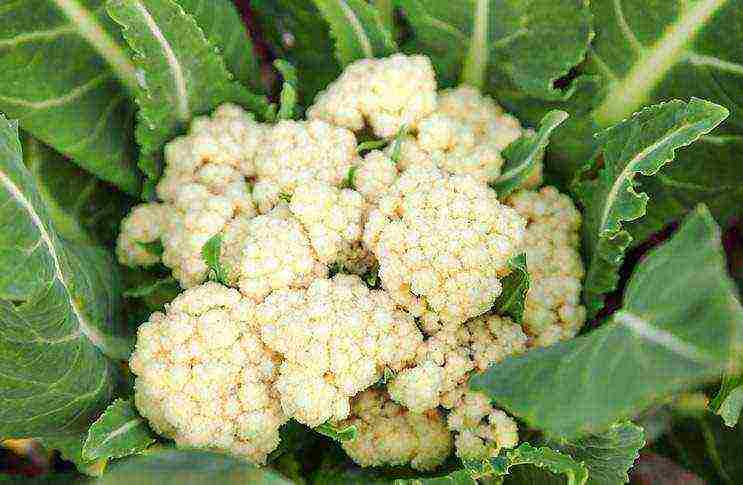
Everyone can choose from a variety of varieties and hybrids of cauliflower, adapted to one or another climatic conditions. In central Russia and the Moscow region, early and mid-season varieties of cauliflower can be grown, the late ones usually do not have time to ripen.
The most important thing is to choose the right variety and grow the cauliflower in seedlings.
Cauliflower varieties for the middle lane are undemanding to light and heat, are resistant to sudden changes in humidity and air temperature, most of them ripen no later than mid-October:
- Gribovskaya early - an early variety that tolerates slight shading well, heads weighing up to 700 g are slightly loose, but have good taste.
- Early ripening is a relatively disease-resistant early ripening variety with round, dense, juicy white heads.
- Warranty - early variety with long-lasting heads weighing up to 850 g.
- Alpha is an early variety, the heads are large (up to 1.5 kg), but they are not stored for long.
- The snow globe is a medium-early variety resistant to diseases and cold, large snow-white heads weigh 1.2 kg.
The cauliflower varieties Moskvichka, Shirokolistnaya, Express, Snezhinka, Movir-74, Round head grow well in central Russia.
In Siberia and the Urals, before the onset of cold weather, only early varieties of cauliflower, and grown exclusively by seedlings, have time to ripen.
The following varieties are popular with gardeners:
- Opal is an early fruitful variety, the heads (up to 1.5 kg) are white, dense and uniform, ripen almost simultaneously.
- Baldo is a very early variety, high-yielding, with medium-sized milky-white rounded heads.
- Helsinki is a hybrid variety, the heads are snow-white, large.
- Whiteskel is a hybrid variety resistant to diseases and climatic conditions, dome-shaped heads, uniform, dense, weighing up to 3 kg.
- Candide charm F1 is a hybrid variety with a well protected head up to 2 kg.
The varieties of cauliflower Lilovy ball, Snezhniy ball, Movir-74, hybrids Cheddar F1, Amphora F1 are also suitable for the Siberian climate.
When to plant cauliflower seedlings?
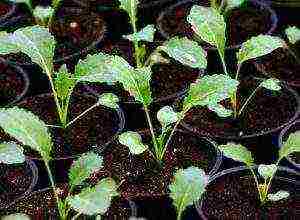 The timing of sowing cauliflower for seedlings depends on the timing of ripening of varieties and hybrids. Cauliflower heads are laid at a temperature of 20-30 ° C.
The timing of sowing cauliflower for seedlings depends on the timing of ripening of varieties and hybrids. Cauliflower heads are laid at a temperature of 20-30 ° C.
If there is scorching heat when the inflorescences are laid, only leaves will grow, not inflorescences. If during the period of head formation the temperature drops to 10 ° C, the quality and quantity of the crop will significantly deteriorate.
Depending on the varieties and the period of their ripening, cauliflower seeds are sown at the following times:
- Early ripening (80-110 days): mid to late March.
- Early (115-125 days): early March-early April.
- Mid-season (126-135 days): first decade of April-first decade of May.
- Late (145-170 days): end of May-mid-June.
Seedlings planted at 20-25 days of age give the best results.
Landing dates for different regions of Russia
The final fruits of the labor of gardeners are highly dependent on the temperature regime in different regions.Cauliflower can be grown almost everywhere, but the sowing dates for seedlings are slightly shifted for different regions. In central Russia and the Moscow region, cauliflower is sown from mid-March to late May (intervals - 10-20 days).
Compared to central Russia, in Siberia and the Urals, early varieties are sown on April 10-15, middle and late ones - at the end of April. Sowing dates in southern Russia have been shifted to February. Early cabbage varieties can be sown here for seedlings already in early February, and in April ready-made seedlings are planted in the ground.
Seed preparation
Before germination, cauliflower seeds must be calibrated and tested for germination. First, they are examined and selected healthy and large in appearance. Then incubated for 20 minutes in a container with water at a temperature of 50 ° C. Seeds that have sunk to the bottom are removed and immersed in cold water for a minute, and those floating on the surface are discarded.
Calibrated cauliflower seeds are soaked for 8 hours in a 1% solution of potassium permanganate. For better germination of the seed, special preparations with a disinfecting effect are used, which stimulate the growth of seeds, for example, "Epin".
In a solution of 2 drops of the drug in 100 ml of water, the seeds are kept for 12 hours, stirring occasionally. Garlic juice, diluted 1: 3 with water, also serves as a good disinfectant for cauliflower seeds. After thoroughly rinsing, the treated seeds are placed in the lower drawer of the refrigerator and kept for a day.
Soil preparation
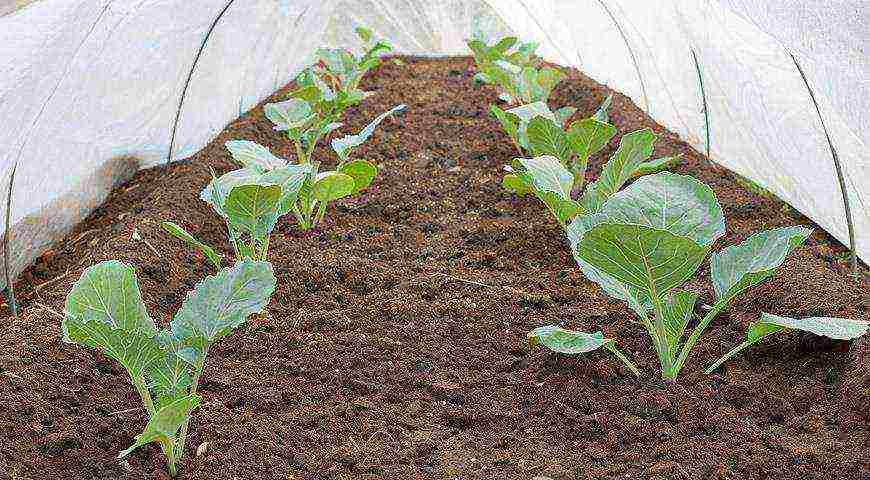
Before sowing cauliflower seeds for seedlings, it is important to take care of the nutritious soil for growing it. You can buy it or cook it yourself by mixing 7 parts of peat, 2 parts of compost or humus, 1 part each of sod land and a rotted mullein.
It should be borne in mind that the texture of the soil for cauliflower should be lighter, therefore, it is advisable to add 1 liter can of coarse river sand and rotted sawdust to the prepared soil mixture. The soil prepared for sowing on cauliflower seedlings should not be acidified, but neutral.
To deoxidize 1 liter of earth, add 15 g of dolomite flour or 20 g of furnace ash. To disinfect the soil, it is pre-frozen for 1-2 months on the balcony or in the yard in the open air.
How to prepare a container?
To get an early harvest of cauliflower, seeds are germinated in separate bulk or peat pots. Subsequently, the seedlings will not have to be dived, which they are hard to bear.
Peat tablets, cassettes or cardboard egg trays are also suitable for germinating seeds. Thanks to this agricultural technique, seedlings are grown without picking. When using wooden boxes for sowing seeds for seedlings, they must be disinfected with a dark solution of potassium permanganate or boiling water.
How to plant seeds?
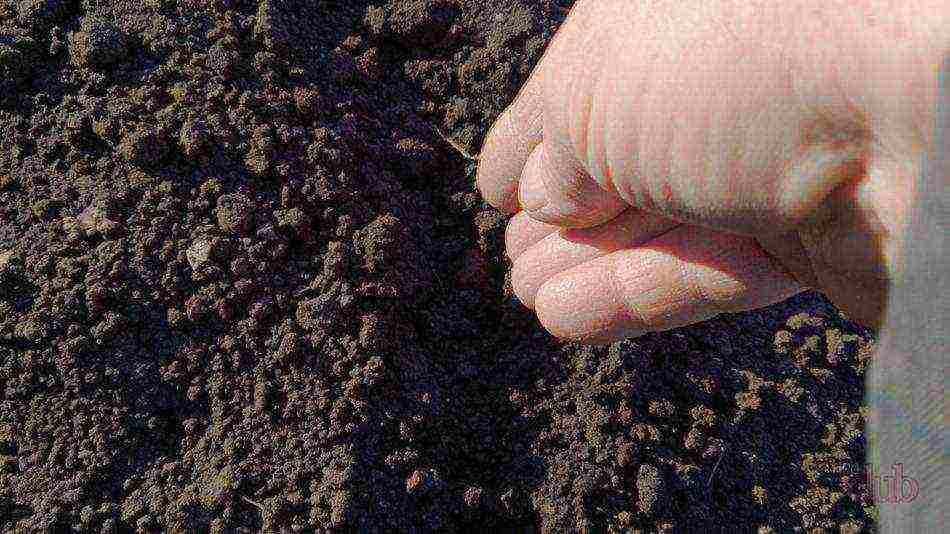
Processed cauliflower seeds are dried and sown in individual cups or seed boxes. In each pot or hole, 2 seeds are traditionally placed, which are deepened by 1.5 cm.
After that, they are sprinkled with soil and mulched with steamed dry river sand. Then the container is covered with foil or glass and placed in a warm (18-20 ° C) dark place.
After seed germination, a weaker sprout is removed by cutting it at the root. To prevent stretching, the seedlings are placed closer to the light, the temperature is lowered to 6-8 ° C. After 5-7 days, the temperature is increased to 15-18 ° C in the daytime, and up to 8-10 ° C at night.
If the seedlings of cauliflower are grown in a room where the temperature exceeds 22 ° C, subsequently they may not form inflorescences at all.
How to dive seedlings?
Cauliflower seedlings do not tolerate picking well. For those who decide to sow seeds in a common box, and not in separate containers, it is recommended to choose dishes deeper, and place the seeds in it less often, so as not to damage the roots of seedlings by replanting them into open ground.
For gardeners who consider it necessary to dive the cauliflower seedlings, it is recommended to plant them in separate containers at the age of 2 weeks, carefully trimming the roots during transplantation. While the seedlings take root after the pick, they are kept at a temperature of 21 ° C, after that the temperature regime is set at 17 ° C during the day and 9 ° C at night.
Cauliflower Seedling Care
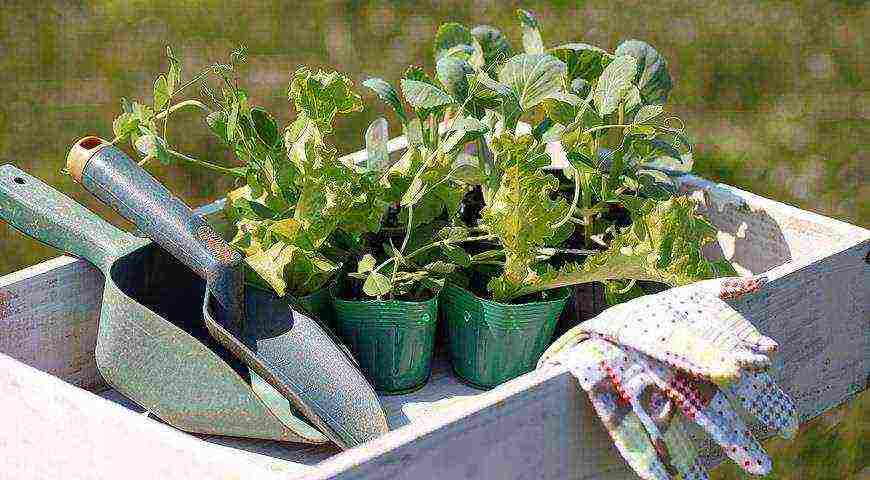
During the seedling period, caring for cauliflower includes moderate watering, regular loosening of the soil and preventive soil treatment with a 0.5-1% solution of potassium permanganate to protect against black leg and other fungal diseases.
After the development of 2-3 true leaves in seedlings, they are sprayed by dissolving 2 g of boric acid in 1 liter of water. When the seedlings grow another 1-2 leaves, it is recommended to process the seedlings by dissolving 5 g of ammonium molybdate in a bucket of water.
Seedlings of cauliflower require periodic feeding. The first feeding is carried out after the appearance of 2-3 true leaves, the subsequent ones - with an interval of 10 days.
For feeding use:
- infusion of wood ash (glass 200 g) for 10 liters of water;
- infusion of mullein 1:10 with the addition of superphosphate (1 tablespoon).
Cauliflower is a delicious vegetable. And useful at the same time. In order to get an early harvest, it is grown in seedlings. This technology is simple, but it is necessary to follow some recommendations. Further in the article, we will consider how to properly grow cauliflower seedlings at home.
Basic techniques
Good cauliflower seedlings can be produced in two ways: conventional and potted. In the first case, the seeds are planted in boxes or in a greenhouse. The second uses special peat pots. A rather weak and tender root system is what makes cauliflower different. Seedlings, the cultivation of which is not a very difficult procedure, will rise well and will be strong only when using very loose soil. Therefore, it is best to use the second technique. You can also use mixed technology. That is, plant the seeds in boxes or a greenhouse, and make a dive in peat pots.
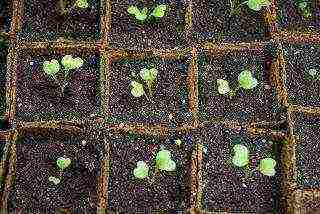
Timing
45 days is the period for which a large and strong enough cauliflower seedling can be obtained to carry in the beds. Growing it usually begins in late March - early April. This is if you want to get an early harvest. More accurate dates depend on the region in which the plot with the vegetable garden is located. They will be earlier in the southern regions of Russia. In the middle lane and in Siberia, sowing is started later.
By subtracting 45 days from the period of possible transfer to the open ground, you can accurately calculate the time when the cauliflower seedlings should be planted. Growing it (it is better to use early varieties) in a greenhouse or in pots in this case will allow you to get a harvest at the end of summer. Of course, only if all technologies are followed. The most popular early ripening varieties are Movir 74, Gribovskaya 1355, Otechestvennaya, etc.
Late varieties of cauliflower are more often planted at the end of April - in May in a greenhouse. In this case, the harvest can be obtained in September - October.
Preparing the ground in boxes
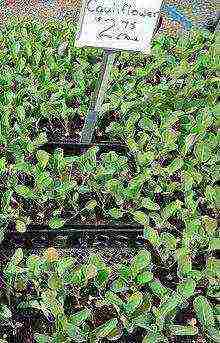 Seedlings of cauliflower, the cultivation of which must be done correctly, reacts very painfully to the lack of nutrients in the soil. Therefore, the soil for it should be prepared very carefully. A mixture consisting of equal parts of turf, humus and peat is just perfect for growing strong, healthy plants. It would be very nice to add a little phosphorus fertilizer to the ground under the cabbage (for example, 20 g / m2 of granular double superphosphate).
Seedlings of cauliflower, the cultivation of which must be done correctly, reacts very painfully to the lack of nutrients in the soil. Therefore, the soil for it should be prepared very carefully. A mixture consisting of equal parts of turf, humus and peat is just perfect for growing strong, healthy plants. It would be very nice to add a little phosphorus fertilizer to the ground under the cabbage (for example, 20 g / m2 of granular double superphosphate).
It is imperative to also disinfect the soil by spilling it with a weak solution of potassium permanganate. To prevent disease of seedlings with black leg, calcined sand should be prepared. They are poured over the surface of the soil in boxes after planting the seeds.The sand can be replaced with quality wood ash.
Seed preparation
The planting material must first be calibrated, heated and etched. For growing seedlings, large seeds should be taken. The use of such planting material can improve the yield by about 30%. Sowing larger seeds results in a stronger cauliflower seedling. Growing at home will be even more successful if you pre-warm the planting material. To do this, it is placed in a gauze bag and immersed in very warm water (50 grams) for 20 minutes. Next, the seeds are dried and pickled. Disinfection can be carried out with a formalin solution (1: 300) or garlic juice (1 hour for 3 hours of water) for an hour.
Transplanting
The soil in the boxes is carefully leveled. Next, the actual seeds of a culture such as cauliflower are planted. Seedlings, which are grown at home on windowsills, will germinate well and quickly when the seeds are buried in the ground by about 1 cm. After embedding, the surface is sprinkled with calcined sand or ash. Further, the soil in the boxes should be thoroughly shed using a spray bottle.
Caring for small seedlings consists in periodic moistening of the soil and weeding, if necessary. Cauliflower is planted in a greenhouse in about the same way. It is best to cover it with a special film, for example, "Svetlitsa". Such material transmits sunlight well and is hygroscopic (does not collect condensation).
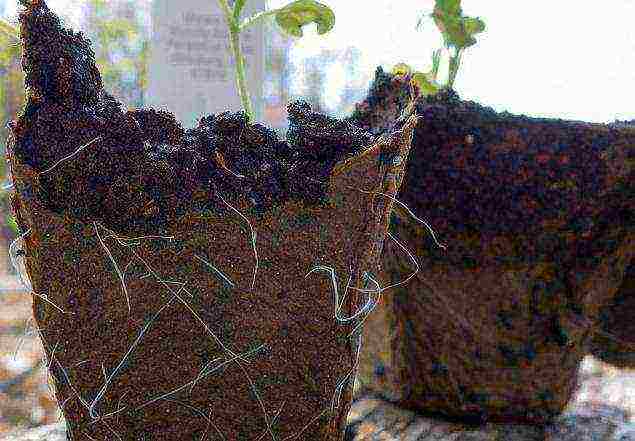
Seedlings of cauliflower: how to grow
Before shoots appear in the boxes, the air in the room must be warmed up to at least 18-20 grams. The same temperature should be maintained in the greenhouse. In order for the air under the film not to cool down in the dark, the structure should be covered with some kind of improvised material: straw mats, old blankets, etc.
After the cabbage rises, the ambient temperature can be reduced to 6-8 degrees during the day, and up to 5-6 grams at night. This will help strengthen and harden the plants. After a week, the temperature should be increased to 10-12 grams. and maintain at this level for about 10 more days, up to a pick. This mode will allow you to grow healthy, strong, not pampered seedlings.
Picking
This procedure is carried out a week and a half after the cauliflower seedlings sprout. Growing and caring for it also presupposes the correct transplant. It is impossible to delay the timing of the pick. In older plants, when transferred to other containers, the root system suffers greatly. As a result, they take root much worse and develop in the future.
The pick is best done in peat pots. In this case, when transplanting plants into open ground, their root system will not be damaged, and they will take root much faster and better. A pick is carried out in such a way that the plants are immersed in the ground up to the cotyledon leaves. At the end of this procedure, the cabbage should be mulled with wood ash.
It is better to dive not all plants at once. A few bushes should be left in the boxes just in case. The easiest way to buy peat pots is from a specialized store. But you can make them yourself.
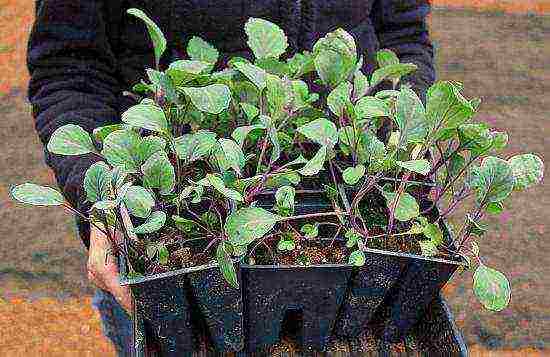
How to make peat pots
By following the above method, very good cauliflower seedlings can be grown. We have figured out how to plant it. Now let's see how to make peat pots for seedlings. For manufacturing, you will need to prepare:
- Low-lying peat with a pH not higher than 6.5. The more sour can be sourced. This procedure is carried out no earlier than two weeks before the disembarkation of the seedlings.
- Wood sawdust. The day before making the pots, you need to add a little ammonium nitrate (1 kg per 1 m3) to them. It is introduced in order to prevent the depletion of the soil mixture.The fact is that the bacteria that process sawdust absorb a lot of nitrogen from the environment (in this case, a peat mixture).
- Sand.
- Fresh mullein diluted with water 1x1.
For three parts of peat, take 1 part of sawdust and 0.2 parts of sand. You need very little mullein (5% of the total) - only for gluing the mixture. Otherwise, the walls of the pots will turn out to be very dense and hard, and the roots will not be able to break through them. A little mineral fertilizers (ammonium nitrate, superphosphate and potassium chloride) and lime should be added to the mixture of sawdust, peat and sand. It is best to make pots on the same day when the pick will be carried out.
How to grow cauliflower seedlings in peat tablets
This is a fairly new technology that allows you to get very strong plants. Purchased peat tablets just need to be put in plastic cups and poured over with warm water. After a while, they will swell and transform into a nutrient mixture. One or two seeds are placed in each glass.
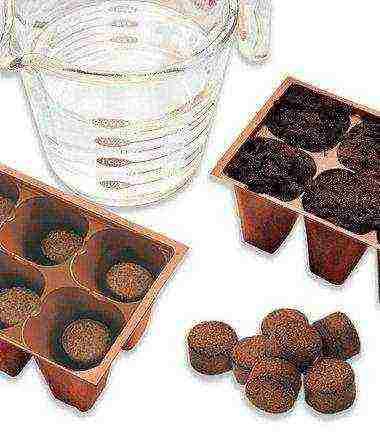
Growing without picking
This method has recently become more and more popular among domestic gardeners. It also produces very good cauliflower seedlings. In this case, cultivation is carried out from the first day in peat pots. However, this method is best used for late seedlings. That is, when it is supposed to be carried into the ground in the summer.
Without picking, you can grow late seedlings right in the garden. Seeds in this case are sown quite rarely (according to the scheme 10x56 cm). Plants are cared for in the same way as when growing in boxes, pots and greenhouses. To protect the seedlings from frost, arcs are installed and a film is pulled over them. Usually, small cabbage takes up only a small part of the bed space. After four leaves grow on it, it is distributed over the entire area.
How to fertilize
In order for the seedlings to grow healthy and strong, it should be fed with mineral preparations at least twice. For the first time, the plants are fertilized about 10 days after the pick. The second is after another 10 days. For feeding, you can use a solution of ammonium nitrate.
Seedling hardening
Preparation of this kind allows you to get the most frost-resistant plants. Hardening begins about 12 days before planting in open ground. To do this, in the daytime, the seedlings are taken out onto the balcony or placed in a greenhouse at an air temperature of about 5 grams. At night, the pots must be returned to a warm room. Five days before disembarkation, the seedlings can be rearranged from the room to the greenhouse. In warm weather, the film is periodically removed from it, gradually increasing the interval when plants are in the open air.
How to transfer to open ground
Using the technologies described above, a very good seedling of cauliflower can actually be obtained. Growing it in the open field is also done according to certain methods.
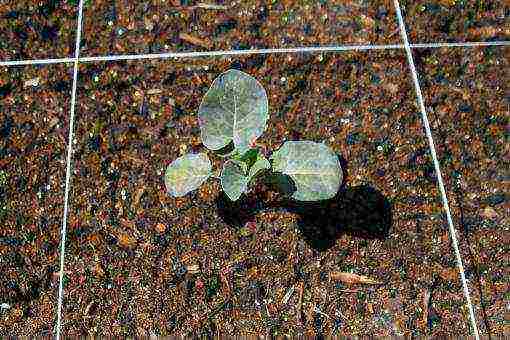
Small holes are made under the seedlings with a depth slightly more than the height of the pots. Place cabbage in rows at a fairly large distance. The free space between the bushes should be at least 25 cm. The rows are placed at a distance of 70 cm from each other. This planting scheme is suitable for early cabbage varieties. For the later ones, both distances should be increased by about 10 cm.
The pots are lowered into the ground and dropped in such a way that the plant is buried to the first leaves. At the final stage, the grown seedlings should be thoroughly watered.

Well, now you know how good cauliflower seedlings can be produced. Growing it at home, as well as carrying it to open ground, are simple procedures, but they require strict adherence to certain technologies. The main thing is to meet the planting dates, prepare a good soil mixture and do not forget to water the plants.
Cauliflower is the richest source of proteins, vitamins and minerals. Almost every person who owns their own summer cottage or vegetable garden grows cauliflower. And today we will teach you how to do it correctly in order to end up with a rich, healthy and tasty harvest.
How to grow cauliflower
Which variety should you choose?
The varieties listed below are suitable for growing both in climatic conditions, for example, in the Moscow region, and in the territories of Siberia and the Urals. For convenience, we classify varieties in accordance with the rates of their growth and ripening.
- Early ripening. Movir 74, Early Gribovskaya 1355.
- Medium early. Mid-season Fargot, Pioneer, etc.
Cauliflower Pioneer
- Late ripening. For example, Skywalker F.
Important note! Cauliflower does not feel very well at temperatures over +25 degrees. Residents of hot regions are advised to give preference to Coleman and Ameizing varieties - they normally tolerate such conditions.
Ameising F1, a Dutch bred hybrid, with heads weighing up to 1.8 kg, high-yielding
Where to plant cauliflower?
We choose a warm and sunny area - in the shade we get only a lot of leaves without a fully formed head. Cabbage likes moist soil and air. The best option is sandy loam and loamy soil with a neutral pH (in the range of 6.8-7.2) and rich in humus.
Determining the best soil type for planting cauliflower
Cauliflower can be planted in areas previously used to grow legumes, cucumbers, carrots, as well as cereals, onions and potatoes. Areas where turnips and radishes, tomatoes, radishes, beets, and cabbage were previously grown, can be used for growing cauliflower only 4 years after the last harvest of the listed crops.
Preliminary preparation recommendations
Both seeds and soil need preliminary preparation.
Cauliflower seeds
The seeds are preliminarily dipped in water heated to about 50 degrees and kept there for 15 minutes. After that, we send them to cool water for about 1.5 minutes. Next, we will need to soak the seeds in a solution containing microelements (we buy in a specialized store) for 12 hours, then rinse them thoroughly with water and send them to the refrigerator for about a day.
Seed soaking
In the photo - sowing cauliflower seeds for seedlings
We begin to prepare the plot in the garden for the future planting of cauliflower from the autumn months, by introducing lime substances. In the spring, we apply organic fertilizers in the amount of 1 bucket per square meter. Add a mixture of a couple of large tablespoons of superphosphate, a small spoonful of urea and a couple of glasses of wood ash to each prepared hole.
We grow home seedlings
We will grow seedlings in a mixture consisting of equal proportions of sand, peat and turf. Components such as humus and soil from the garden will not work - there is a high risk of infection of plants with a black leg.
For sowing early varieties, we choose a day between March 5 and 10, late ones - March 10-20. If you wish, you can sow seeds directly into the ground under the film - we do this in April.
Sowing cabbage seeds in the ground
We propose to increase the chances of getting a healthy and strong harvest by first growing the seedlings in boxes, and then transferring them to the ground.
Seedling growing procedure
Traditionally, boxes are used with a height of about 100 mm, a width of about 300 mm and a half-meter length. For convenience, the longitudinal wall of the box is made detachable.
Seedling wooden box
We lay small stones at the bottom of the box to ensure drainage.
Expanded clay can be used for drainage
We fill the container with soil mixture. We level it, slightly moisten it and thicken it a little. We mark grooves on the surface of the soil with a depth of about 5 mm, maintaining a 3-centimeter step between them.In the row between the seeds, we provide approximately 10 mm distance. We fill the seeds with a soil mixture and compact it a little.
Sowing seeds in seedling boxes
After sowing, we maintain an approximately + 20-25-degree temperature in a room with future seedlings. When shoots appear, reduce the temperature to approximately +10 degrees. After a week of this regime, during the day the temperature is maintained at + 15-17 degrees, at night - + 9-10 degrees. It is not necessary to get warmer - the heads will form too early.
Water in moderation. Excessive moisture will provoke the development of a black leg, too little watering will lead to the formation of dwarf heads.
Moderate watering
Two-week-old seedlings go through the picking stage, i.e. seating in separate containers. Sometimes this is done already on the 9-10th day, transferring the seedlings into cups measuring about 8x8 cm.
Seedling picking
The recommended depth of seedlings is up to cotyledon leaves. Within 3 days after the pick, we maintain the temperature at about + 19-20 degrees, then reduce it to + 16-17 degrees during the day and about + 9-10 degrees at night.
Early varieties are transplanted into the garden in the first days of May, and later ones - within 2-3 weeks of the same month. Approximately 2 weeks before transplanting, the seedlings begin to gradually accustom themselves to temperature extremes, wind and sun, i.e. tempered.
Recommendations for the care of home seedlings
The standard scheme is as follows.
- During the first 4-5 days after sowing (i.e. before the first shoots appear), the soil is sprayed with water. It is very convenient to do this with a spray bottle. During this period, the container with future seedlings is kept in a room with a temperature of + 18-20 degrees.
Spraying seedlings
- After the emergence of the first shoots, home seedlings are transferred to a room with a temperature of up to + 8-10 degrees. In warmer conditions, it will stretch too much.
- After 9-14 days, the seedlings are transplanted into separate containers. Recommendations for the correct conduct of this stage were given earlier.
An example of planting seedlings in separate cups
- After the germination of two true leaves, foliar feeding of the emerging cauliflower seedlings is carried out. We prepare the mixture for feeding as follows: we dilute half a small spoonful of fertilizers containing a complex of trace elements in a liter of cool clean water. We use the mixture for spraying. The second time we feed it before the start of hardening with a mixture of 0.15 g of molybdenum-sour ammonium, 0.2 g of boric acid, as well as 0.15 g of copper sulfate per liter of pure water. The final foliar feeding is carried out when the cabbage head grows to the size of a walnut. This time, spraying is done with a solution of the following composition: 10 liters of water, a large spoonful of potassium sulfate and a similar amount of urea. Each plant is sprayed with a glass of a similar mixture.
Top dressing of seedlings. Leaf spraying
- 5-7 days before transplanting seedlings into the ground, we stop watering. A couple of hours before planting, we properly water the seedlings with clean water at room temperature.
Water the seedlings at the root
Landing
The optimal timing for planting home seedlings in the ground was mentioned earlier, but some owners do it much earlier - already in the first weeks of April. During this period, at night the air temperature can still drop below 0. To ensure the protection of the seedlings, it is covered with pieces of plastic wrap laid on small arcs.
For 1 plant of early varieties, a plot of 0.4x0.5 m is needed, mid-ripening - 0.5x0.5 m, late - 0.6x0.6 m.Seedlings are deepened to the level of the first true leaves. During the first 2-3 days after planting, home seedlings should be carefully shaded.
Rules for planting cabbage in the ground
Water it every 5-7 days, in moderation. Watering is best done using the sprinkler method.To reduce the frequency of watering, plantings should be mulched with organic fertilizers in accordance with the instructions.
After watering, we loosen the soil by about 7-8 cm in depth. The first hilling is carried out 3 weeks after cabbage planting. The second - after another 10 days. Some owners carry out the first hilling after 2 weeks after planting the seedlings, the second after the same time. As practice shows, both methods give equally good results.
Cauliflower, seedlings
3 weeks after planting, we add top dressing in the form of a liquid mullein or other suitable composition (check in a specialized store in accordance with the variety of cabbage grown). For dusting the soil and cabbage, you can use wood ash in the amount of one glass for every square meter. Such processing will allow you to get rid of pests and at the same time act as a top dressing.
Growing cauliflower in a greenhouse
Cauliflower pests and control
Cauliflower care
Inspect cabbage stalks regularly for small white cabbage fly eggs. Collect and destroy those. If many stems are affected, apply 1-3 waterings with insecticide. The solution is poured at the root, there is no need to process the entire plant.
Insecticides
Young cabbage leaves can be infected with cabbage moth eggs. The caterpillars hatched from them soon will pose a great danger to the entire crop. The situation is saved only by treating the entire plant with insecticides in accordance with the instructions for the selected tool.
Cabbage pest
Important! Chemical treatment is not carried out if the heads have already begun to be tied.
For processing cabbage, not only chemical poisons are suitable, but also products based on plant components.
Milkweed infusion is well suited against the caterpillars of the whiteworm, moths and scoops. Pour a kilogram of its roots and leaves with about 4 liters of water, put on low heat, bring to a boil and boil for about 3 hours. Then we filter the broth and add water to it in such an amount that the total volume increases approximately 3 times. We use it for watering affected plants.
Burdock helps against the same pests. We fill the bucket with burdock to about a third of the height and pour water to the edges of the container. We leave it for 3 days. We filter the infusion and use it for weekly spraying of plants.
Using Burdock Leaves for Pest Control
And lastly, a useful note: do not waste time and energy trying to grow cabbage on acidic soil - nothing good will come of it. Lime the soil and work to normalize its pH values.
Soil liming
Good luck!
Video - How to grow cauliflower in the garden
Growing cauliflower seedlings is not too difficult. It is enough to follow some recommendations, and you will not have problems with this culture.
Cauliflower is not only tasty but also healthy. Therefore, it is definitely worth planting her on your site. But first you need to grow high-quality seedlings. How to do it?
Seed sowing dates
Typically, cauliflower seedlings are ready to "move" to the garden on the 45th day. Therefore, it can be sown from late March - early April. Then you can get an early harvest. But this is on condition that the varieties are early. Today, among the early varieties of cauliflower, Alfa, Gribovskaya 1355, Movir 74, Sierra, Otechestvennaya, Express are popular.
Sowing dates for cauliflower largely depend on the region and weather conditions. If you know roughly when it is best to plant cabbage outdoors in your area, just count back 45 days from this date - and you will get the time for sowing seeds for seedlings.
What is the substrate made of?
Seedlings of cauliflower need nutritious soil for successful growth and development.Therefore, it is worth preparing a special mixture consisting of sod land, humus and peat, taken in equal parts. If you take land from the site, it must be disinfected with a pink solution of potassium permanganate.
How do I prepare the seeds?
Sort the cauliflower seeds before sowing. It is worth sowing only the largest specimens - this allows you to grow stronger seedlings and increase yields by 30%.
Next, it is recommended to warm up the seeds by immersing them in hot water (about 50 ° C) for 20 minutes, and then pickling them in a pink solution of potassium permanganate for about 8 hours. The first procedure promotes the early germination of seeds. The second helps to disinfect the seed.
Sowing cauliflower seeds
Cauliflower is usually sown to a depth of about 1 cm. The distance between the seeds should be 10 cm. After sowing, it is recommended to sprinkle the soil surface with a small layer of calcined sand or ash to prevent black leg. Then the crops should be sprayed with a spray bottle. If you water them with a watering can, the seeds can go deeper into the soil and germinate worse.
Seedling care before picking
Before the emergence of seedlings, crops must be kept at a temperature of 18-20 ° C. After the cabbage has risen, the temperature should be reduced to 6-8 ° C in the daytime and 5-6 ° C in the evening. After a week, the temperature is raised slightly - up to 10-12 ° C. Under such conditions, cauliflower seedlings should grow for about 10 more days (before picking). This procedure will help to harden the plants. They will grow strong and resistant to changes in the weather.
Picking cauliflower seedlings
The pick is carried out 1-1.5 weeks after the emergence of shoots. It is better not to delay when transplanting cauliflower seedlings, because in older plants it is easy to damage the root system, as a result of which they will not take root well.
It is best to dive cauliflower into peat pots. They will also help protect the roots of the seedlings, since you can transplant plants outdoors in these containers. In addition, such seedlings take root quickly and safely. But it's okay if you transplant the seedlings into any other containers you have.
When picking, each seedling must be buried in the soil up to the cotyledonous leaves. After the procedure, the soil in separate pots can be sprinkled with wood ash.
How to feed the seedlings?
In order for the seedlings to grow healthy and strong, it is advisable to feed them 1-2 times with mineral fertilizers. The first feeding is usually carried out 10 days after the pick, the second - after another 10 days. Potash fertilizers (10 g) and superphosphate (20 g) can be used as top dressing, which are diluted in 10 liters of water.
Hardening of cauliflower seedlings
12 days before planting in open ground, cabbage seedlings should be placed on a balcony or in a greenhouse (with a temperature of 5 ° C) in the daytime. The seedlings should be returned to the premises at night. 5 days before transplanting, they can be transferred to a greenhouse. During the day, it can be periodically ventilated so that the plants adapt to life in the open air.
Practice these guidelines for growing cauliflower seedlings and you will have healthy, high-quality plants ready for transplanting outdoors.

